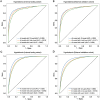Development of deep learning algorithm for detecting dyskalemia based on electrocardiogram
- PMID: 39353972
- PMCID: PMC11445469
- DOI: 10.1038/s41598-024-71562-5
Development of deep learning algorithm for detecting dyskalemia based on electrocardiogram
Expression of concern in
-
Editorial Expression of Concern: Development of deep learning algorithm for detecting dyskalemia based on electrocardiogram.Sci Rep. 2025 Apr 8;15(1):11969. doi: 10.1038/s41598-025-96414-8. Sci Rep. 2025. PMID: 40199974 Free PMC article. No abstract available.
Abstract
Dyskalemia is a common electrolyte abnormality. Since dyskalemia can cause fatal arrhythmias and cardiac arrest in severe cases, it is crucial to monitor serum potassium (K+) levels on time. We developed deep learning models to detect hyperkalemia (K+ ≥ 5.5 mEq/L) and hypokalemia (K+ < 3.5 mEq/L) from electrocardiograms (ECGs), which are noninvasive and can be quickly measured. The retrospective cohort study was conducted at two hospitals from 2006 to 2020. The training set, validation set, internal testing cohort, and external validation cohort comprised 310,449, 15,828, 23,849, and 130,415 ECG-K+ samples, respectively. Deep learning models demonstrated high diagnostic performance in detecting hyperkalemia (AUROC 0.929, 0.912, 0.887 with sensitivity 0.926, 0.924, 0.907 and specificity 0.706, 0.676, 0.635 for 12-lead, limb-lead, lead I ECGs) and hypokalemia (AUROC 0.925, 0.896, 0.885 with sensitivity 0.912, 0.896, 0.904 and specificity 0.790, 0.734, 0.694) in the internal testing cohort. The group predicted to be positive by the hyperkalemia model showed a lower 30-day survival rate compared to the negative group (p < 0.001), supporting the clinical efficacy of the model. We also compared the importance of ECG segments (P, QRS, and T) on dyskalemia prediction of the model for interpretability. By applying these models in clinical practice, it will be possible to diagnose dyskalemia simply and quickly, thereby contributing to the improvement of patient outcomes.
© 2024. The Author(s).
Conflict of interest statement
The authors declare no competing interests.
Figures



References
-
- Goyal, A. et al. Serum potassium levels and mortality in acute myocardial infarction. JAMA307, 157–164. 10.1001/jama.2011.1967 (2012). - PubMed
-
- Gennari, F. J. Hypokalemia. N. Engl. J. Med.339, 451–458. 10.1056/NEJM199808133390707 (1998). - PubMed
-
- Betts, K. A. et al. The prevalence of hyperkalemia in the United States. Curr. Med. Res. Opin.34, 971–978. 10.1080/03007995.2018.1433141 (2018). - PubMed
MeSH terms
Substances
Grants and funding
LinkOut - more resources
Full Text Sources

